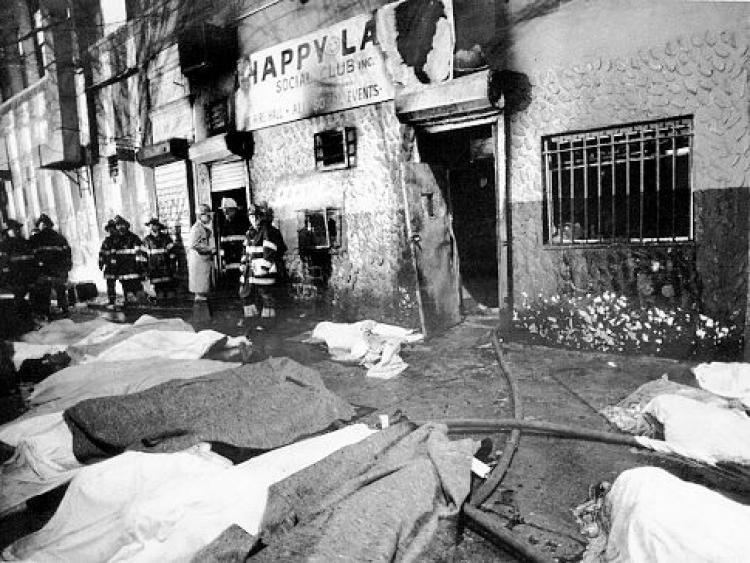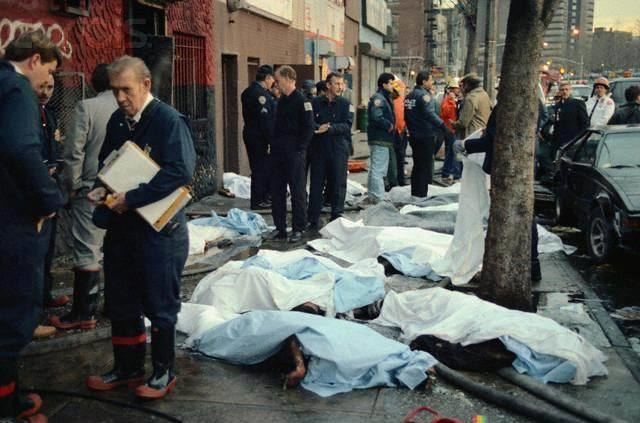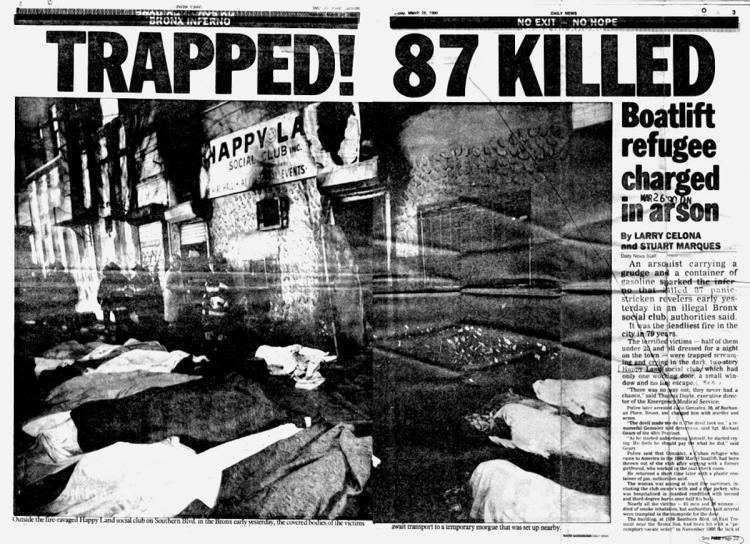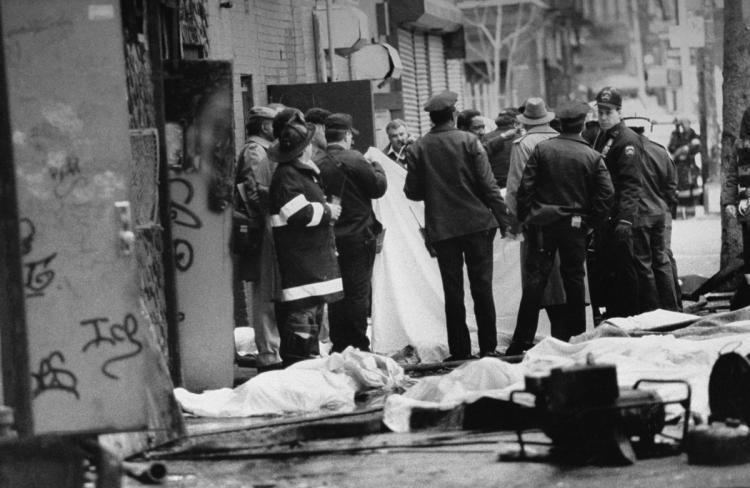Non-fatal injuries 6 | Deaths 87 Perpetrator Julio González | |
 | ||
Date March 25, 19903 a.m. EDT Similar Beverly Hills Supper C, Cocoanut Grove, The Station nightclub fire, Ozone Disco Club fire, Rhythm Club fire | ||
Arsonist who torched 87 people in horrific 1990 happy land fire dies in prison
The Happy Land fire was an Arson fire that killed 87 people trapped in the unlicensed Happy Land social club at 1959 Southern Boulevard in the West Farms section of the Bronx in New York City on March 25, 1990. Most of the victims were young Hondurans celebrating Carnival. Unemployed Cuban refugee Julio González, whose former girlfriend was employed at the club, was arrested soon afterward and ultimately convicted of arson and murder.
Contents
- Arsonist who torched 87 people in horrific 1990 happy land fire dies in prison
- Background
- Incident
- The arsonist
- The club and premises
- Legacy
- References

Background

Before the blaze, Happy Land was ordered closed for building code violations during November 1988. Violations included lack of fire exits, alarms or sprinkler system. No follow-up by the fire department was documented.

González served three years in prison in Cuba in the 1970s for desertion of the Cuban Army. In 1980, he faked a criminal record as a drug dealer to help him gain passage in the Mariel boatlift. The boatlift landed in Florida, he then traveled to Wisconsin and Arkansas and eventually settled in New York, sponsored by the American Council for Nationalities in Manhattan.

Six weeks before the fire, he split up with his girlfriend, Lydia Feliciano. Before that, González had lost his job at a lamp factory in Queens. At the time of the fire, he was two weeks behind on the rent of his room, and the owner of the boarding house where he was staying said of him "From what I know, he was down to his last hope."
Incident

The evening of the fire, González had argued with his former girlfriend, Feliciano, who was a coat check girl at the club, urging her to quit. She claimed that she had had enough of him and did not want anything to do with him anymore. He was ejected by the bouncer about 3 a.m. EDT. He was heard to scream drunken threats such as he would "shut this place down."

González went to an Amoco gas station, then returned to the establishment with a plastic container with $1 worth of gasoline. He spread the fuel at the base of a staircase, the only access into the club, and then ignited the gasoline.
Eighty-seven people died in the resulting fire. Nineteen bodies were found downstairs; the others upstairs. Six bodies were found within several feet of the front door. Some of those trapped punched a hole through a wall to an adjoining union hall in an attempt to escape. Most of the deaths were from asphyxiation or due to having been trampled. Most of the victims were young Hondurans celebrating Carnival, largely drawn from members of the local Garifuna American community. The fire was the deadliest in New York City since the Triangle Shirtwaist Factory fire in 1911, and the deadliest in the United States since the Dupont Plaza Hotel fire in Puerto Rico in 1986. It would be the deadliest fire in the United States until the 1995 Oklahoma City bombing; the most lethal building fire in New York City until the World Trade Center's towers caught fire during the September 11 attacks; and the most fatal nightclub fire in the United States until the Station nightclub fire in West Warwick, Rhode Island, in 2003.
There were only about five or six survivors. Amongst them were Feliciano, the club owner’s wife and a disc jockey. The disc jockey was hospitalized in guarded condition with second and third-degree burns over half his body.
The blaze was extinguished in just five minutes, with 150 firemen having responded.
The arsonist
After setting the fire, González then returned home, removed his gasoline-soaked clothes and fell asleep. He was arrested the following afternoon after police investigators interviewed Feliciano and learned of the previous night's argument. Once advised of his rights, he admitted to starting the blaze.
González was charged with 174 counts of murder, two for each victim, and was found guilty on 87 counts of arson and 87 counts of murder on August 19, 1991. For each count he received the sentence maximum of 25 years to life (a total of 4,350 years). He was eligible for parole during March 2015 as New York law states that the sentences for multiple murders occurring during one act will be served concurrently, rather than consecutively.
González was denied parole in March 2015. He would have been eligible to apply for parole again in November 2016, but he died of a heart attack on September 13, 2016 at the age of 61.
The club and premises
The building that housed Happy Land club was managed partly by Jay Weiss, at the time the husband of actress Kathleen Turner. The New Yorker quoted Turner saying that "the fire was unfortunate but could have happened at a McDonald's". The building's owner, Alex DiLorenzo III, and leaseholders Weiss and Morris Jaffe, were found not responsible criminally, since they had tried to close the club and evict the tenant. During 1987, Weiss and Jaffe's company, Little Peach Realty Inc., had leased the building space for seven years to the club owner, Elias Colon, who died in the fire. An eviction trial against Mr. Colon had been scheduled to start on March 28.
While they were found not responsible criminally, the city filed misdemeanor charges during February 1991 against DiLorenzo, the building owner, and Weiss, the landlord. These charges claimed that the owner and landlord were responsible for the building code violations caused by their tenant. They both pleaded guilty during May 1992, agreeing to perform community service and paying $150,000 towards a community center for Hondurans in the Bronx.
There was also a $5 billion lawsuit filed by the victims and their families against the owner, landlord, city, and some building material manufacturers. That suit was settled during July 1995 for $15.8 million or $163,000 per victim. The lesser amount was due mostly to unrelated financial difficulties of the landlord.
Legacy
The street outside the former Happy Land social club has been renamed "The Plaza of the Eighty-Seven" in memory of the victims. Five of the victims were students at nearby Theodore Roosevelt High School, which had a memorial service for the victims in April 1990. A memorial was erected directly across the street from the former establishment with the names of all 87 victims inscribed on it.
Additionally, the band Duran Duran wrote the song "Sin of the City", which appeared on the band's 1993 self-titled album, about the fire. The song "Happyland" on Joe Jackson's album Night and Day II, released in 2000, was also inspired by this event.
In the aftermath of a warehouse fire in Oakland, California, in December 2016, which killed 36 people, comparisons were drawn to this fire. The Oakland fire also occurred in a space that was being used for parties in violation of law and lease agreement. Investigations of the law and lease agreements were pending at the time of that fire as well.
